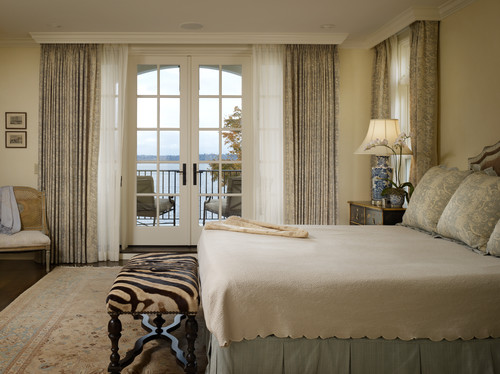Decorator fabrics – the very term seems daunting to some people, especially when they see the price tag on these specialty fabrics. Like any high-quality, made-to-last purchase, custom-made draperies should be thought of as an investment. Here are some of our top tips on how to choose the right decorator fabrics for your draperies, especially if you live in a warm, humid climate like southeastern NC:
Factors to Consider When Choosing Fabric for Draperies for Your Southern Home:
- Thread count: Decorator fabrics have higher thread counts than clothing fabrics or fabrics you would find in a regular store. This makes them long-lasting, but terribly uncomfortable when made into clothes (we’re looking at you, Scarlett O’Hara!).
- Durability: Sun rot is the big bad wolf of drapery fabrics. All fabrics will experience sun damage over time, but the sun is especially cruel to silks. If your heart is set on silk draperies, be sure your window doesn’t get a lot of direct light, or be sure to line the window with a shade or light-colored liner to help protect them.
- Styles: There are just about a million different styles when it comes to draperies. Some styles to look out for?
- Damask is a popular drapery weave that you’ll often see in silk and linen.
- Grosgrain is a ribbed silk. In draperies, it’s often used as a ribbon trim.
- Ticking is striped, usually black and white, blue and white, or red and white. It’s a cotton fabric treatment and is used most often for informal curtains.
- Velvet is closely woven and typically made of silk, cotton, or nylon. It has a uniformly cut pile on one side, which is what makes it soft. It’s durable and used for heavy draperies, but has fallen out of style in recent years.
- Natural vs. Synthetic: There are two major categories for decorator fabrics: natural and synthetic. Both natural and synthetic fabrics have their pros and cons, so there’s no need to shy away from synthetic fabrics just on principle. Your main natural fabrics are cotton, wool, linen, and silk. The synthetics you’re likely to see are polyester, rayon, nylon, acrylic, and acetate. You’ll also find blends, like cotton-polyester, for those people who want the best of both worlds.
|
The Best of the Best Natural
Synthetic
|
The Worst of the Worst
Natural
- Wool: Wool’s not bad in a blend, but in Wilmington, our climate is too mild in the winters and hot in the summers for wool to make comfortable draperies.
Synthetic
-
- Rayon: Rayon takes the cake for the worst drapery fabric for the Wilmington area, due to its tendency to shrink upward in humidity.
Have more questions about draperies or decorator fabrics? Come to a Strickland’s showroom and talk to our resident drapery expert or fill out this quick contact request form!
Error: Contact form not found.

